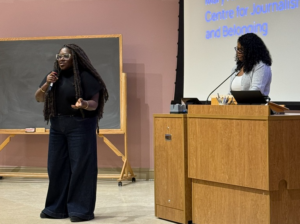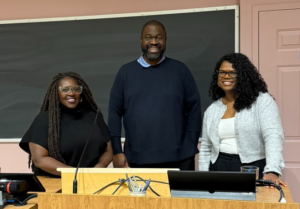 Addressing a room of King’s journalism students and faculty, Professors Eternity Martis and Nana aba Duncan shared one of the most surprising things they’ve found in their research: that they’re the first to do it.
Addressing a room of King’s journalism students and faculty, Professors Eternity Martis and Nana aba Duncan shared one of the most surprising things they’ve found in their research: that they’re the first to do it.
“Black folks have never been asked about how they are perceived in the news. No one’s taking the time to ask,” said Martis, who is an assistant professor at Toronto Metropolitan University’s School of Journalism. “We’ve been having all these initiatives about diversity and inclusion and better reporting, but no one has asked Black folks.”
Duncan, an associate professor who holds the Carty Chair in Journalism, Diversity and Inclusion Studies at Carleton University’s School of Journalism and Communication, admits she’s still continually surprised by this oversight, and that every so often, she’ll ask Martis, “Look, are we sure there’s nothing written out there right now? That this doesn’t exist in Canada?”
Martis’ answer is always the same: “Yeah, it’s just not there.”
Through focus groups in Toronto, Halifax, Edmonton and Montreal, Martis and Duncan are collecting qualitative data from Black community members about the impact the news has had on them, as well as speaking with non-Black journalists about their preparedness to report in Black communities. Their data will inform a comprehensive guidebook that will equip journalists with the tools they need to do so adequately and respectfully. While the professors were in Halifax hosting one of these focus groups, Professor Brian Daly took the opportunity to invite them to King’s.

Leading groundbreaking discussions in journalism is nothing new for Martis and Duncan. Martis is an award-winning journalist whose debut memoir, They Said This Would Be Fun: Race, Campus Life, and Growing Up, has been featured on must-read lists across the country. She has been challenging representations of Black communities in media since her own time as a journalism student when she was told “you can’t write about that.” Her response was to just keep going. “I just kept doing it,” Martis told the King’s event. “I just kept writing it, and then I got called back to talk about it years later.”
Duncan recalls a similar experience, saying that when she was a journalism student, she felt like she couldn’t share her worries about the negative impact of news coverage on Black communities. Now, she’s blazing a trail as the first Black journalism professor at Carleton, where she works to reshape the fundamentals of journalism education to inspire more inclusive coverage and more ethical newsrooms.
As the founder and director of the Mary Ann Shadd Cary Centre for Journalism and Belonging, Duncan has been conducting research to foster a more inclusive journalism industry, including leading the Reporting in Black Communities project with Martis.
Reflecting on the origins of their project, Duncan and Martis spoke to how Black communities are often portrayed through a narrow lens in Canadian media, if portrayed at all.
“We see Black folks represented in areas of crime, in sports and entertainment, and we rarely see positive stories,” Martis said, to which Duncan added, “Unless it’s exceptionalism.” These (mis)representations leave little room for everyday stories that reflect the full depth of Black experiences.
Media plays a powerful role in shaping public attitudes and the consequences of these misrepresentations extend far beyond the newsroom. Martis provided an example of how this happens:
“Let’s say somebody doesn’t have any Black people in their life and they only see Black people represented in crime on TV … and they think that Black folks are inherently criminal. Okay, then they get chosen for jury duty….” By creating a tool journalists can use to more comprehensively report in Black communities, Martis and Duncan seek to disrupt these biases.
Their research uses a harm-reduction framework to ask critical questions: How has the media harmed Black communities in Canada? How can that damage be repaired? How can journalists engage with Black communities in ways that foster trust rather than perpetuate harm?
“You don’t want to be the person that only ‘talks about’ and doesn’t ‘speak with.’ So be the person who speaks with.”
–Nana aba Duncan
As the floor opened to questions, it was clear the audience was keen to learn more about best practices. Students and professors alike raised their hands to share how stories they’re currently working on could benefit from this guide. They also sought advice about how they might better report in Black communities.
Martis shared something she always tells her students.
“Before you even think about your story, you should spend a few weeks getting to know people,” she said. “We should be showing up for things, not just showing up when we need a story and it’s convenient for us.”
Duncan echoed these thoughts, stating “you don’t want to be the person that only ‘talks about’ and doesn’t ‘speak with.’ So be the person who speaks with.” Don’t assume that people don’t want to speak with you, Duncan added.
Martis continued: “In reality, a lot of people really do want to speak with you. You provide a platform.”
Applause rang through Alumni Hall as the lecture concluded, and several students made their way down to the podium to speak further with Martis and Duncan.
Daly reflected on how impactful it was for both students and faculty to learn from Martis and Duncan, who provided a historical context and practical tips that “are not only about reporting on Black communities, as it turns out, but in fact, are some of the best practices in reporting that can definitely be of help.”
Remarking on the lack of studies in Black communities generally, Daly expressed his gratitude for Martis and Duncan’s work.
“Thank goodness we now have two researchers who are trying to fill that gap as best they can.”

